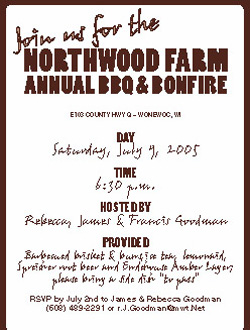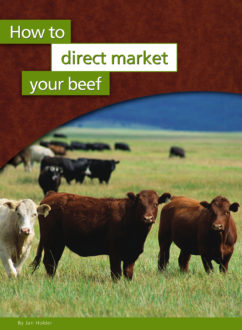
You can obtain a lot of free PR, but it usually requires some effort on your part. Are you doing something interesting that could make a news story? If you have a story to tell, the press will probably write about it. Are you raising your beef differently than your neighbors? Are you fencing off areas for a threatened species? Are you providing internships for local kids?
Call the local papers and ask who covers environmental issues, agricultural issues or human interest. Then write a note to the appropriate person and include all the pertinent details. It doesn’t have to be too fancy, but make sure it goes to the correct person. Include one of your brochures and the name and number of a contact person, in case they need more information or they want to send out a reporter or photographer. Hit all local TV, radio, newspapers and magazines. When you get a little larger, it will be helpful to make up a press kit. This will contain all the information in your brochure, plus a lot more specific information about your-self, your beliefs, and your operation. Also include any press clippings at the back. Another way to obtain free exposure is to offer yourself for speaking engagements.
Call local civic clubs if you have an interesting story to tell. Locate the special-interest clubs in your area that might be interested in what you have to say. Maybe it’s a story about your efforts to restore health to the rangeland. Again, make sure that these are your target customers. Speaking at a soup kitchen shelter may be a wonderful thing to do, but those people are probably not going to have the discretionary income to purchase your product. Speaking to the local chapter of the Sierra Club, if you are speaking of your ranch’s conservation efforts, is probably a better bet.
The same is true for product sampling. It works really well to distribute samples to a pre-qualified group. For instance, we give out product information and samples at our biggest client’s yearly new-product fair. We give out jerky samples at farmers markets. We give our beef to a wildlife rehabilitation center’s annual fund-raising dinner.
Paid advertising in newspapers, magazines, yellow pages, outdoor boards, radio and television are generally useless to the small beef producer. They are too expensive to cost-effectively reach your narrowly target-ed customers. Do not even speak to the advertising salespeople who will contact you. They are armed with a lot of charts, graphs, demographics, psychographics, double-speak, and gobbledygook. Remember: All advertising salespeople have their agendas. They will do anything to sell a $30 radio spot. That is all you need to know.
The kind of paid advertising that works well is narrow in focus. Match your advertising plan to your target market. Advertise in catalogs that sell your product, but not if you focus on farmers markets or sides of beef. Give away informational flyers in the stores that carry your products. Print up small table tents to place on tables in restaurants that sell your products. These are generally very effective and inexpensive.
Remember to stress the benefits to the consumer. Make it simple. Don’t try to say too much in one ad. Make all type at least 12 points in size. Make headlines very short. Always include your logo and where to buy your product. Always include a “call to action.” Tell them clearly what you want them to do: “Call 1-928-428-0033 and order today,” or “stop by Tucson Cooperative’s Cash-and-Carry Outlet and pick up some steaks today!”
The Internet is the hot advertising medium right now. Some producers find that websites – such as LocalHarvest.org and EatWild.com, which maintain directories of direct market farmers – provide good promotional channels. Local Harvest, for example, calls its nationwide directory of local food sources “the No. 1 informational resource for the ‘buy local’ movement and the top place on the Internet where people find information on direct marketing family farms.” You can register yourself for free, and their search engine will help people find you when they’re looking for meat produced off the grid.
It may or may not work for you. We found that directory-type websites are an excellent resource for our customers to learn more about us, our company, and our standards. Since we developed our own website, our telephone time spent with customers wanting to know if we treat our cattle humanely, or if we feed animal by-products, has been cut almost to nothing. However, accepting online orders never worked for us. It is simply impossible in Arizona to ship product even overnight with specialized packaging, and have it arrive intact in the month of August. Even though we were specific about the geographic area that we serve, we continually had to field inquiries from far away spots like Japan. So we use the web as an educational support system for our clients.
